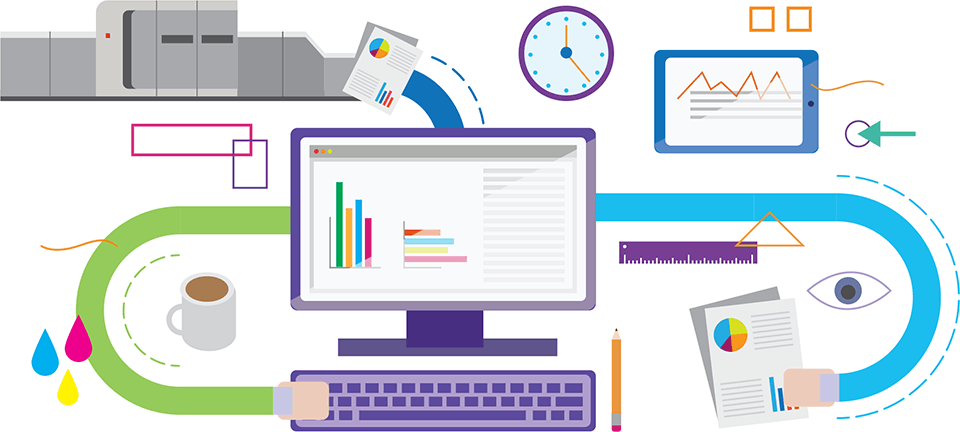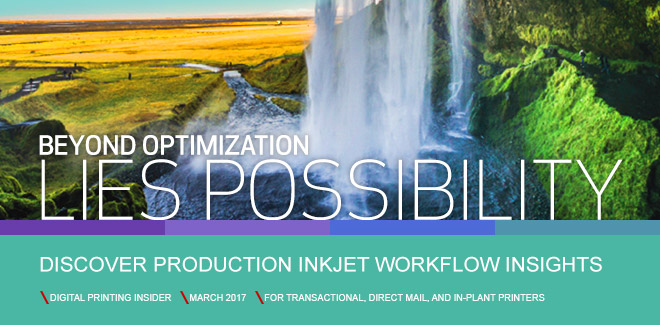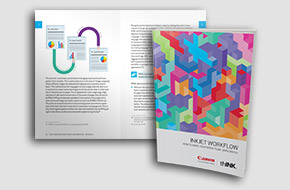New Printing Industry Book Provides Insights into How to Make Your Work Flow More Efficiently
When you think of workflow, what comes to mind — document submission, prepress automation, production management, file conversion, data cleansing and optimization, mail stream management? Workflow is all of this and more. It encompasses all the processes that allow you to get from concept to a final product with a minimum of manual steps and make sure everything along the way is optimized.
But do your eyes glaze over when contemplating the integration of a new production inkjet press into your print shop? Does it seem too complicated, confusing, or overwhelming? What options are available for your situation? What questions should you be asking, and where can you get some help to make your print shop run more efficiently? How do you get started in leveraging your strengths, identifying your process gaps, and making plans to fill those gaps?
A new book is available to help you do just that.
Sponsored by thINK, the independent community of Canon Solutions America production print customers, and published by Canon Solutions America, this book provides a thorough discussion of the steps in a digital workflow and the options available today to help print service providers better understand where to focus their efforts and where additional investments might improve their shop’s efficiency. Entitled Inkjet Workflow: How to Make Your Work Flow… Efficiently, its goal is to help print service providers streamline and optimize their operations to become more successful and profitable.

Why should you care? Because an efficient workflow is critical to your ability to be the most cost-efficient producer of whatever communications you generate. By taking as many steps out of the overall process and eliminating as many human touches as possible, print service providers can reduce costs, improve margins, and shorten overall production time to become a more cost-efficient producer. A streamlined, cost and time-efficient workflow can be a huge competitive differentiator.
The book covers the following steps in a digital production print workflow:
Print Datastreams
Print service providers are asked to accommodate a wide variety of file formats from their customers, normalize them in the prepress stage, and create print-ready files for production. Depending on market applications, some may be legacy line data formats, some may be proprietary formats, and some may be more open formats. This chapter discusses the various file types you may need to work with, how they have evolved, and their relative advantages and disadvantages.
The Role of Data
Marketing today is driven by data because making a message relevant to the recipient enhances that customer’s experience with the vendor, which can enhance revenue, customer loyalty, and overall program efficiency. Production inkjet printing makes it possible for print service providers to tailor their customers’ offers to different audiences to improve results. This chapter discusses the steps involved in finding the right data, organizing it, and analyzing it to leverage inkjet’s inherent advantages to personalize marketing campaigns plus the role print service providers can play in this process.
Document Creation
This step defines all the project deliverables. For a successful outcome, proper planning and communication with the project owner and all stakeholders should occur early in the design process. This chapter details the questions to ask as you move through the planning and execution of a campaign.
Document Submission
Significant improvements in productivity can be realized by increasing the level of direct and compatible interconnection when transferring a document, identifying the source, and identifying the content. This chapter discusses the various document transfer methods available, the role of metadata in describing the file content, the use of portals, and various web-to-print solutions.

Document Preparation
This step covers accurately processing a file for reproduction to meet the customer’s expectations. The chapter discusses various standards and best practices in creating a print-ready file and what to check for in preflight to both meet a client’s requirements and create a smooth and efficient workflow.
Data Optimization
This step is a critical component of document production and distribution. With the many sources of data available today, there is an increasing need for efficient workflows to accurately manage large amounts of data in a cost-effective way. This chapter discusses data cleansing, data mining, privacy protection, and optimizing data for direct mail cost reduction.
Output Management
Single digital print devices managed by stand-alone digital front ends (DFEs) create islands of print technology or production silos. As print service providers grow, merge, or operate in multiple locations, they can benefit from enterprise-wide or more centralized output management solutions to align most or all of their production instead of managing each device independently. This chapter details the various tasks in a production workflow, what a DFE needs to support, the types of workflow software systems available, and the growing use of visual workflow automation models.
Post-processing and Delivery
Much of the work done in the file preparation and output management stages affects the accuracy and efficiency of post-processing. This chapter discusses the trade-offs of in-line vs. offline finishing, job tracking and print regeneration tools, and the types of mailing software solutions available.
Professional Services
Integrating the many components of a workflow to create an automated end-to-end workflow often requires the help of professional services. This chapter looks at typical workflow bottlenecks, the value of professional services in enabling print providers to execute their overall strategy and meet operational goals, what to consider when searching for professional services, and what is required in a workflow automation implementation plan.
Your workflow process is the heart of making your business successful. To learn more about how you can create a production workflow best suited to your needs, the book can be purchased for $29.99 through the Printing Impressions store.

